Where do the names Hoi An, Faifo, and Cochinchina originate?
Hoi An has many names. The name Hoi An ("association" + "safe" or "secure") suggests a protected gathering place or a joining together for safety. The branch of the Thu Bon River running past this port town was once called the Hoài River. Thus, the city's early name may have been Hoài Phố, with "phố" meaning "street" or "small village." Or, the name may have been Hải Phố, which means "Sea Street." Or, perhaps it was Hoa Phố, where the "Hoa" is the Vietnamese term for "overseas Chinese." First Western missionaries and traders had only seen the port's name written in Chinese characters. They may have heard one of these names and written the sounds down as "Faifo." Another spelling, "Fayfoo," appears on the map by Pieter Goos drawn in 1666. Thomas Bowyer's journal written between 1695 and 1696 mentions Foy Foe, while a map drawn by Alexander de Rhodes says Haifo and a map from the (Auguste) Pavie Mission Indochina Papers (1879-1895) printed in the English edition (1903) use Fai Fo.
The word "Cochinchina" is also sometimes a source of confusion because the term has referred to different geographic areas at different times. "Cochin" is believed to be a distortion of "Giao Chi," a name the Chinese used for Vietnam during their domination. "China" was added to distinguish the area from the settlement in India, also called Cochin. The Portuguese were the first to use "Cochinchina," but their term referred only to the mouth of the Mekong River.
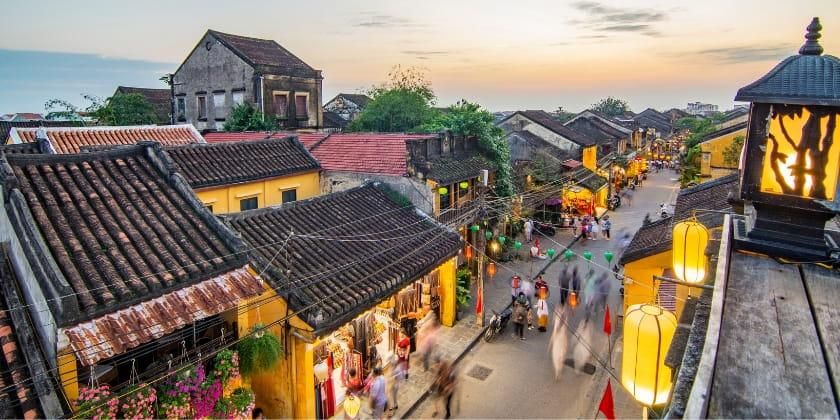
However, after the 17th century, Westerners applied "Cochinchina" to all the territory ruled by the Nguyen lords to distinguish Nguyen's land from that of the Trinh lords based in Tonkin (northern Vietnam). Thus, during the time of the Nguyen and Trinh lords (mid-16th century to the end of the 18th century), Hoi An was in Cochinchina. Later, during French colonialism, Cochinchina" referred to the area around Sai Gon, which became a French colony. Hoi An was in Annam (the Center), which was a protectorate. Hanoii was in Tonkin (the North), also a protectorate.
How did the Japanese Cao Lau noodles become a Hoi An specialty?
In 1990, the Japanese Toyota Foundation sponsored a seminar in Hoi An. Japanese scholars attending the seminar recognized cao lâu as one of their traditional dishes and believe it may have been imported three centuries before. They were surprised that Hoi An's Cao Lau tasted so much better than the Cao Lau served in Japan.
If this Hoi An noodle specialty doesn't impress you, its history will. Of course, you will be tempted to try the dish when you are in Hoi An just because it's so famous.
Cao Lau came to Hoi An with the Japanese in the late 16th century. Although some Japanese merchants married Vietnamese women and learned to enjoy Vietnamese food, others imported food from their Japanese homeland, especially a rice noodle dish similar to today's Cao Lau. ("Cao Lau '' refers not only to this noodle dish but also to a high-class, specialty dish that is "Chinese," meaning that for Vietnamese it is reserved for special occasions.)
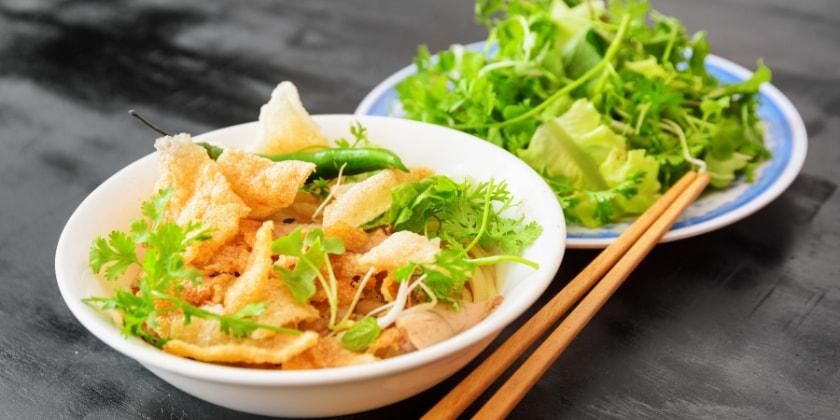
These days, the Cao Lau noodles in Japan are factory-made. However, Hoi An Cao Lau noodles are homemade. The Japanese scholars asked the most famous restaurant in Hoi An to demonstrate its traditional noodle-making method. Cooks first rinse the rice in well water. (In olden times, Hoi An was a fresh-water stop for ships moving north or south. Every house had a fresh-water well lined with wood, bricks, or stone like the famous Ba Le Well in the alley of 35 Phan Chu Trinh.) They squeeze the rinsed rice to remove the water before they husk and polish it.
They grind the rice into flour, adding a little ash water to turn it light yellow. The cooks place the dough on the top of a special double boiler called a xửng, which has banana leaves on the bottom. Water boiling in the lower pot creates steam that enters the top layer through holes. Then the chefs roll out the dough, cut it into noodles with a knife, and steam the noodles again before serving.
The chefs stir-fry thin slices of lean pork with fish sauce until they become a toasty brown; they save the cooking juice to use as a sauce with the noodles. They place fresh herbs, including rau đắng (bitter herbs), rau thơm (mint), and giá (bean sprouts) in a bowl, add the noodles and meat slices, and cover the mixture with the sauce, soy sauce, and vinegar.
Mix it all up and enjoy!
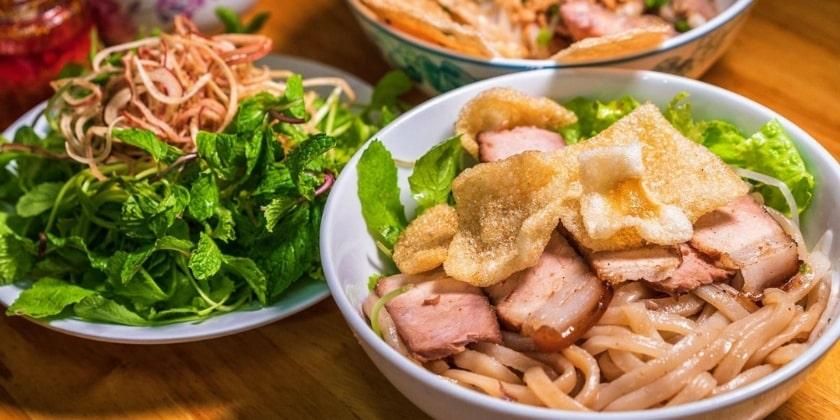
Some people like to crumble up a flat, crisp Banh Da rice cracker on top of the Cao Lau. Banh Da, which makes a great snack, are made from old rice grains that retain most of their brain even after being soaked in water to acquire the right kind of "sour-ness". Cooks grind the wet grains into a paste and add some boiled rice that has cooled. They spread two layers of this smooth paste on the hot metal plate of a big steamer. The two layers soon become one wet cracker, which is removed and dried. The chefs sprinkle sesame and groundnuts evenly on the surface while the bánh da are drying but before they become crisp. The cracker is stored carefully and grilled over a charcoal fire just before it is eaten. The griller uses a hand fan to control the fire. These grilled crackers are about thirty centimeters in diameter and curved like a saddle.
Many Hoi An restaurants serve Cao Lau. Each one has its own variation-more pork, wider noodles, or different herbs. The Japanese scholars decided that the Japanese influence from centuries ago has lingered longer in Hoi An in the form of Cao Lau than in the town's architecture.
What charms does Hoi An have for an archaeologist?
Dr. My Dung, one of the few Vietnamese women archeologists, has been excavating sites in Hoi An. However, she is not a rough, sun-tanned woman with clay under her fingernails. Instead, she exudes graceful, fashionable femininity. Her quick smile compels attention.

A Blend of Cultural Elements
Like Hoi An, My Dung’s life combines many influences. Her father is a historian from Dong Nai Province, and her mother is from Thanh Haa, but My Dung was born in Hoa Binh in 1959. Her husband is from Thanh Hoa Province, Dong Son District, the cradle of Vietnam's Bronze Age. They have two daughters, whom she misses when she is away. Her supportive physician husband helps maintain a stable home when she travels to excavation sites.
My Dung spent ten years in Bulgaria studying and working on her doctoral dissertation, Some Archeological Finds from the Late Bronze-Age Culture in Bulgaria. Returning to Vietnam in 1987, she applied to work at the Archeology Institute in Hanoi but was told that the Institute preferred a male Candidate, who would not be "tied down by children.” Nevertheless, Hanoi University appreciated her charm, eloquence, and wide knowledge. She teaches Vietnamese culture courses when she is not working in the field.
The Inspiration
At Hanoi University, My Dung is associated with well-known archaeologists, such as Professors Tran Quoc Vuong and Ha Van Tan. She found herself drawn to a newly opened field of research-the Sa Huynh Culture. Indigenous to central Vietnam, it developed during the Bronze Age and Early Iron Age (about 1500 B.C.). New finds suggest a relationship between the Sa Huynh Culture and that of the Champa. Sa Huynh finds are generally located in sand dunes close to riverways that may have also been settlement areas the Cham later inhabited.
My Dung started work in Hoi An in 1989 under the guidance of Tran Quoc Vuong
and other archeologists. A cemetery called the Hau Xa Site included clay burial jars believed to belong to the Late Sa Huynh Culture. These contained the bones of the cremated dead along with funeral offerings, such as beads. This and other digs show a continuous development from the Late Sa Huynh to the Cham Culture around the 1st and 2nd centuries A.D.
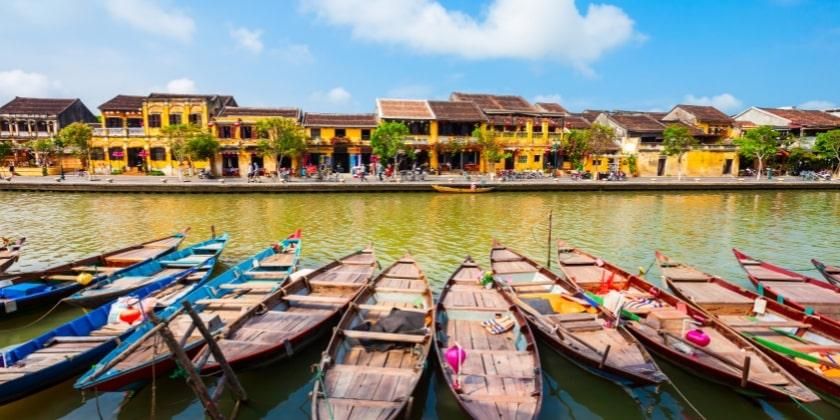
Funeral Customs Live On
My Dung became very interested when current Hoi An residents told her about funeral practices that match findings in the excavated sites. The local residents use white sand for dunnage and burn the ground to warm it before placing coffins on the earth. These practices suggest continuity in burial rites from the final stages of Sa Huynh Culture to the present.
Trade Contacts with Islam
In addition to the burial site excavation, Dr. My Dung completed initial excavations on Cham Island off the coast of Hoi An. Her eyes shone as she showed photographs of her finds. This site has yielded evidence of trade between India, China, Vietnam, and the Middle East.
Hoi An was active in economic and cultural exchanges with the Mediterranean even before the Christian Era. Her team of students and colleagues are finding traces of Islamic trade items on Cham Island, including pottery from the 8th to the 11th century, which traders exchanged for Vietnamese pepper and incense. My Dung has found Middle Eastern black and dark-red glass trade beads as well as beads made with segmented gold and mosaics. Other beads, called Indo- Pacific beads, were made from monochromatic glass and distributed throughout Southeast Asia.
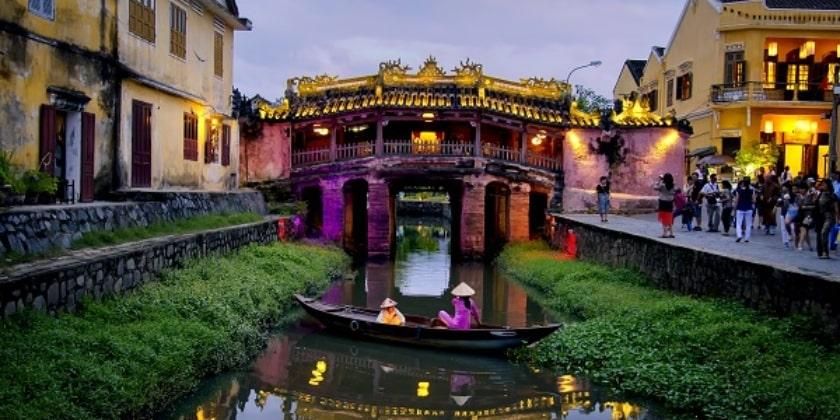
What can we say in summary about Hoi An?
The charming old town of Hội An with its lovely wooden shop-homes has had its ups
and downs, from its rise during the 16th century to a thriving commercial center during the 17th and the 18th centuries to its decline in the 19th century. It endured war for most of the 20th century but has revived in recent years with a new role: commemorating Vietnam's long history of international trade.




